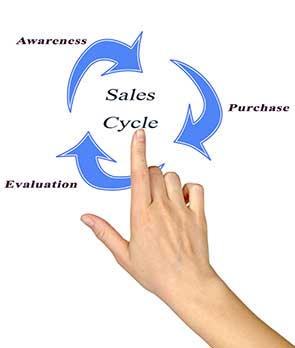 Have you taken the time to document your sales cycle? Many sales leaders I ask have not given this much thought. They claim that each sales situation is unique, impossible to replicate. They say that they only hire tenured sellers who know what to do. Maybe they've never considered it an ‘A’ priority.
Have you taken the time to document your sales cycle? Many sales leaders I ask have not given this much thought. They claim that each sales situation is unique, impossible to replicate. They say that they only hire tenured sellers who know what to do. Maybe they've never considered it an ‘A’ priority.
However, the benefits of clearly articulating each step of your sales process are enormous. I've found that by identifying each step of your ‘typical' sales cycle and detailing what needs to be accomplished in each phase, it's possible to shorten the time from first contact to close. In all cases, by thinking through your ‘ideal' sales cycle and capturing best practices, you become more focused and therefore more effective which leads to improved and predictable results. For example, if you don't have a ‘qualification' aspect early in your engagement, you may be wasting precious time on a prospect that is not a good fit for your products or services.
Return on Investment (ROI)
Sales cycles are building events. In other words, each step builds on the prior step. Therefore there are many critical elements that, when established early, pay off towards the end. A solid sales flowchart shows each phase, the goals of the phase, the outcomes needed to move to the next stage and resources and tools to be used during that phase. One example of a sales tool, often overlooked in early sales stages, is return on investment or ROI. In order to show a powerful ROI in your proposal, you must collect key ROI information early in your exchange with your potential customer. This can be accomplished with open ended questions such as, ‘How do you measure the return on investment for your projects?' or ‘How would you determine, quantitatively, if this initiative is successful?' These questions and others would be captured as essential sales tools during the appropriate stage.
Trigger Events
Another powerful outcome of documenting and analyzing your sales cycle is understanding your specific trigger events. Trigger events are those activities that have a multiplier effect on your close ratio. Are there key sales actions, when completed, will generally increase your chances of success? For many organizations trigger events include demonstrations, pilot programs, site tours or proof of concept activities. Maybe a trigger for your product or service is securing executive sponsorship. Whatever the case for your company, by pinpointing the trigger and flagging it in your sales process, you will put yourself in a position to win more often.
Summary of Benefits
A summary of the enormous value and benefits associated with nailing down your sales process includes:
- A clear path from first contact to close (Predictable outcomes)
- The ability to measure your sales effectiveness (Improved close ratios)
- Identifying your ‘trigger' events (Multiplier effect)
- Once documented, it can be easily communicated throughout the organization (Consistency)
- Shorten the time to close through focus and efficiency (Improved results)
As always, we'd love to hear your success stories!
 Lisa Magnuson, sales strategist and founder of Top Line Sales, LLC, guides high potential sales people and account teams to land larger deals and accelerate sales. Lisa is passionate about her mission to help her clients win more business. How can we help you? You tell us! We craft solutions around your requirements.
Lisa Magnuson, sales strategist and founder of Top Line Sales, LLC, guides high potential sales people and account teams to land larger deals and accelerate sales. Lisa is passionate about her mission to help her clients win more business. How can we help you? You tell us! We craft solutions around your requirements.

